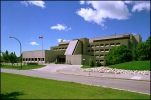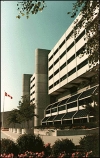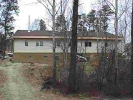Home: Science: Research Facilities: Research Facilities
Research Facilities
501 University Crescent
Winnipeg, Manitoba R3T 2N6

Facility Description:
The Freshwater Institute (FWI) located in Winnipeg, Manitoba is comprised
of five buildings totalling 24,375 m▓. The five buildings within the facility
are the Main Complex, District Office/Storage building, Ozone Waste Treatment
Facility, Annex Building, Solar Warehouse, and Water Treatment Facility
(attached to the main complex). The Freshwater Institute is the Regional
Headquarters of Central and Arctic Region.
Activities:
Activities include freshwater and arctic science, science oceans initiative,
fish habitat management, fisheries management, small craft harbours, corporate
services, communications and regional senior management. The federal Fish
Inspection program, recently transferred to the new Canadian Food Inspection
Agency (CFIA), continues to operate out of the FWI.
Canada Centre for Inland Waters
867 Lakeshore Road
Burlington, Ontario L7R 4A6

Facility Description:
The Canada Centre for Inland Waters (CCIW) houses the majority of
DFO
activities in Burlington, Ontario. Constructed in 1972, the facility is shared
with Environment Canada, who also owns the building. It is comprised of
laboratories including a "wet lab", a marine workshop, a library, an auditorium,
fish specimen archives and storage areas. Vessel support includes the CCGS
Limnos (45m) and the CCGC Shark (16m), as well as numerous smaller craft.
Activities:
The Bayfield Institute, located at CCIW, is comprised of fisheries research,
habitat management, hydrographic surveys and chart production and ships
support. Together with the Freshwater Institute in Winnipeg, it provides
the federal Fisheries and Oceans Science
programs for the Central and Arctic Region. Multiple partnerships with
a variety of external stakeholders allow the Institute to be recognized
internationally as a site of leading research in freshwater science.
The two Science components of the Institute include the regional
Canadian Hydrographic Service (CHS)
and the Great Lakes laboratory for
Fisheries and Aquatic Sciences (GLLFAS).
The regional Canadian Hydrographic Service conducts hydrographic surveys
for the production of navigational charts and related publications for
the St. Lawrence River, the Great Lakes, Hudson and James Bays, along
with many navigable inland waters in Ontario and Manitoba.
CHS also provides
technical assistance for hydrographic surveys conducted in the Arctic.
The main component of GLLFAS is located at CCIW, with a satellite laboratory
in Sault Ste. Marie, Ontario on Lake Superior. Its research program is
a component of the Central and Arctic Region science program and is complementary
to the program conducted at the Freshwater Institute in Winnipeg. The
research programs at both Institutes have a number of common objectives
in the studies of habitat science and environmental toxicology. An all-encompassing
issue on the Great Lakes today is the description of the impact of invasive
nuisance species. The impact of "exotics" affects form, function and quality of
fish habitat and the dynamics of toxic chemicals in the ecosystem.
 Sea Lamprey Control Centre
Sea Lamprey Control Centre
1 Canal Drive
Sault Ste. Marie, Ontario
P6A 6W4

Facility Description:
Located on the grounds of the Sault Ste. Marie Canal National Historic
Site, the Sea Lamprey Control Centre (SLCC) in Sault Ste. Marie consists
of a combined office, lab, warehouse, aquarium, and maintenance and chemical
storage facility. The SLCC houses both Canada's Sea Lamprey Control
program and the satellite research lab of the Great Lakes Laboratory for
Fisheries and Aquatic Sciences (GLLFAS).
The Sea Lamprey Control program
began operating in the Sault Ste. Marie area in 1956, which led to the
construction of the Sea Lamprey Control Centre (SLCC) in 1966. GLLFAS
opened their satellite office in Sault Ste. Marie in 1976, sharing office
space with the Canadian Forest Service. GLLFAS moved to their present
location in the SLCC in 1987.
 Experimental Lakes Area
Experimental Lakes Area
Kenora, Ontario

Facility Description:
The Experimental Lakes Area (ELA)
is a biological and chemical field research facility whose primary purpose
relates to all aspects of freshwater science. The facility began operation
in 1968. It includes more than 20 trailers or buildings as laboratories
and research support. In total there are about 6900 square feet of
laboratory space.
Activities:
The ELA is the main research facility of the Region for freshwater work and the
Central and Arctic Region has the largest inland freshwater responsibility in the
Department. The main activity is fish habitat related research and this is
prominently included in the recent revision of DFO Strategy. The facility is also used
co-operatively with Environment Canada in the long term and has participation
by the Government of Ontario, and Canadian and United States universities.
Co-operative work with forestry and hydroelectric companies is also carried
out at the ELA.
Several experiments are in the planning stages with a number of industrial
and university partners. Examples of currently approved projects include
a major upland flooding project which has support from DFO, Manitoba Hydro
and Hydro-Quebec, and an endocrine disrupter project supported by DFO and
the federal Toxic Substances Research Initiative. One of the major experiments
in the proposal stage is a whole ecosystem study of mercury contamination
in the environment. In addition to DFO, it is expected that participants will
include Environment Canada, University of Alberta, University of Waterloo,
University of Wisconsin, University of Minnesota, University of Manitoba,
Arizona State University, and the University of Texas at Arlington.
 Resolute Bay Laboratories
Resolute Bay Laboratories
Resolute Bay, Northwest Territories

Facility Description:
In the past, DFO has operated a year-round field camp in the Eastern Arctic at
Resolute Bay. As conditions at this facility have deteriorated, the field camp
has not been used for several years. The camp consists of several buildings
including lab, warehouse and living quarters. With an emphasis on co-management
and research related to stock assessment, the resources needed to operate
and upgrade this facility have not been available. However, increasing
interest in Arctic Marine Science and global change issues may result
in the reactivation of this facility in the future.
DFO Science programs are also represented by offices and laboratories in:
- Iqaluit, Nunavut
- Inuvik, Northwest Territories
|